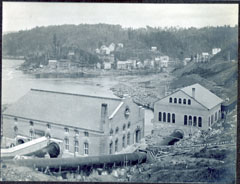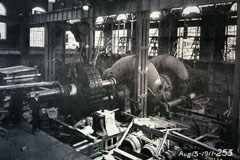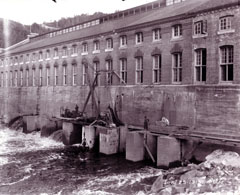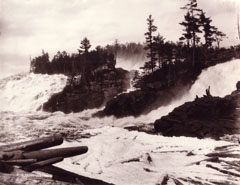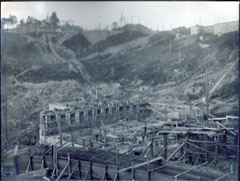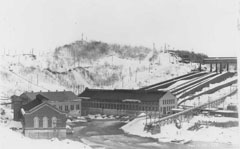Home > History > Shawinigan Water and Power > The birth of a company
The Birth of a Company
At the end of the 19th century, American engineers considered the Shawinigan Falls to be among the best hydroelectric sites in America. A height of forty-two metres and a very strong flow led to the construction of powerful generating stations. The falls had the added advantage of being located in a region near major urban centres in Quebec.
Shawinigan Falls attracted several businessmen, among them Messieurs Carignan and Mailhot of Trois-Rivières, who founded Shawinigan Electric Light and Power in 1895. However, given the lofty financial requirements of the Government of Québec for the purchase of the falls, they were unable to achieve their project to build a generating station. In 1897, the Liberal Party led by Félix-Gabriel Marchand imposed very restrictive sales conditions obliging potential buyers to invest four million dollars within 30 months of their purchase.
The history of Shawinigan Water and Power, one of the most important privately owned electrical companies in Canada, began with the purchase of the Shawinigan Falls in 1897 by John Joyce, a businessman from Boston. He acquired the falls for $50 100. Joyce quickly sought out financial partners and was joined by Messieurs John Edward Aldred, H.H. Melville, A.F. Gault, Thomas McDougall and Louis-Joseph Forget. Together, they founded Shawinigan Water and Power (SW&P), which received its official document of foundation on January 15, 1898.
The history of SW&P was marked by the contribution of John Edward Aldred, who played a major role in the company for more than three decades. He was first treasurer, from 1898 to 1909, before becoming company chairman until 1933. John Edward Aldred was a native of Lawrence, in the state of Massachusetts.
As soon as it was founded, company management sought out industrial clients who would become huge consumers of electricity. In August 1899, SW&P signed a contract with Pittsburgh Reduction that initiated the construction of an aluminum smelter in Shawinigan. This company built its own generating plant and purchased hydraulic energy from SW&P. At the beginning of the next year, Shawinigan Carbide signed a contract to purchase electricity. In August, a Belgian corporation known as the Banque d'Outre-mer of Brussels signed an agreement with SW&P. Construction work on the Belgo pulp and paper mill began a few weeks later.
At the onset of 1902, despite the first generating station in service, the future of SW&P remained uncertain. The company needed to find new clients because Belgo and Shawinigan Carbide had yet to begin production. SW&P intensified efforts and began the construction of a transmission line to supply power to the Montréal region, 135 kilometres away. It was an important technological challenge during the era because the longest power line in America was 35 kilometres, running from the Niagara Falls power plant to Buffalo.
In March 1903, SW&P achieved quite the feat with the commissioning of its 50 000-volt power line, covering a distance of 135 kilometres. Thereafter, SW&P expanded its facilities rapidly through the addition of new groups to its hydroelectric complex. Then, in 1910, the company began the construction of a second generating station near the first that would be expanded, in turn, between 1913 and 1928. In the 1920s, SW&P would add six more generating stations along the Saint-Maurice River. In 1946, the company began work on its third generating station on the site of Shawinigan Falls.





